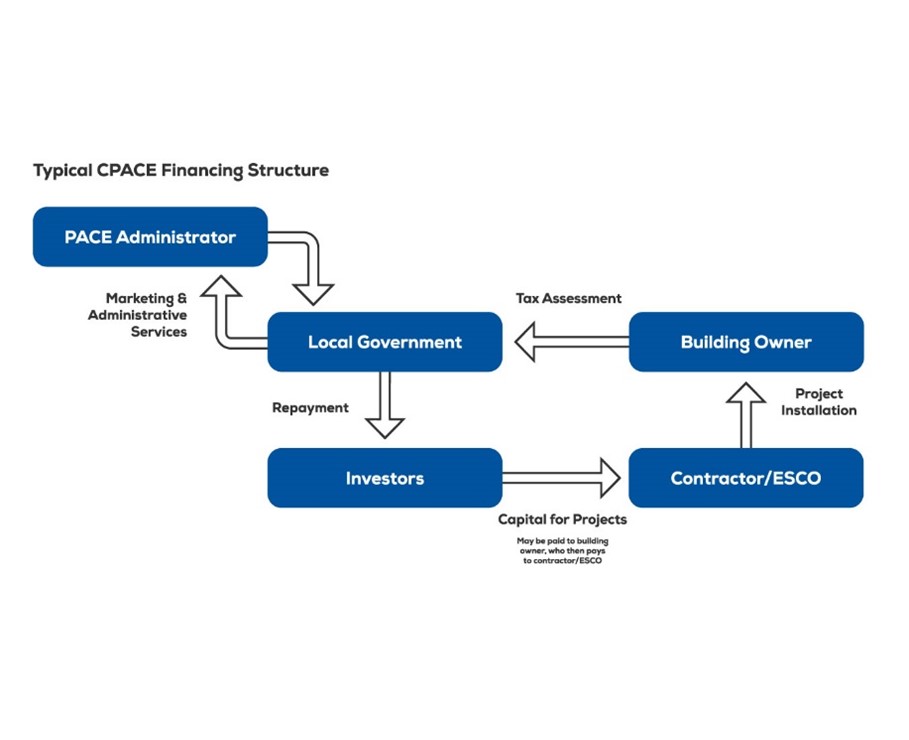
C-PACE loans can help commercial property owners reach their energy efficiency goals now with long-term, low-interest secure financing.
As we move closer to commercial building carbon emissions taxation, property owners are searching for solutions that won’t break the bank. Our commercial buildings are responsible for almost 40% of carbon emissions in the U.S. Consequently, it’s a priority to meet carbon neutrality standards sooner rather than later. C-PACE loans can help commercial property owners reach their energy efficiency goals now with long-term, low-interest secure financing.
What is a C-PACE loan?
It’s a government-initiated program that fosters energy efficiency and carbon responsibility. This funding is designed to provide 100% of a loan amount to implement energy efficiency or renewable energy projects in commercial buildings – upfront.
Somewhat surprisingly, C-PACE loans are available for non-profits, as well as other non-tax paying entities. This is unusual in that the majority of government programs providing funding often skip those who do not pay taxes. C-PACE funding is intended to fuel energy efficiency across the board.

A PACE assessment is a debt of property, meaning the debt is tied to the property as opposed to the property owner(s). Consequently, the repayment obligation may transfer with property ownership if the buyer agrees to assume the PACE obligation. This is also a plus for property owners who would prefer to yield a greater profit at a sale. The C-PACE loan is intended to stay with the owner of the building – even if sold, as long as all parties agree.
It’s important to note that the loan process, like other commercial lendings, can take time and attention to detail. The sooner you can get started, the sooner you will be able to start your project. Funding isn’t released until the process is complete.
According to PACENation market data, 28 states plus D.C. have active C-PACE programs in operation. Over $9.8 billion in PACE financing has been provided for over 375,000 projects. This includes both residential and commercial buildings, (both R-PACE & C-PACE loans). The majority of completed projects fell in the $75,000 – $750,000 size range, though smaller or larger projects are not uncommon.
C-PACE Payback Terms
C-PACE loans are repaid on the property tax bill over a period of 20 to 30 years. This enables a longer payback period, with smaller monthly payments for the commercial property owner. Moreover, this long-term payback results in lower annual payments that are typically less than project savings. Thus, making the necessary changes more attractive to commercial property owners.
How C-PACE Financing Works
To be eligible for C-PACE financing, a project must be located in a county or municipality that has approved C-PACE programs within a state that has passed PACE-enabling legislation. Lists of states that have already implemented the program or are in the process of are below.
The parties involved in a C-PACE deal usually include:
- A PACE administrator that manages the project and ensures adherence to program requirements
- A local government that collects the property tax assessment and remits payment to the capital provider(s) if necessary
- A contractor or energy services company (ESCO) that installs the equipment
- The building owner receiving the upgrade or tenants working in concert with their landlord; and
- Private investors, bondholders, or the government provide the capital.
The project must be approved by the PACE administrator prior to financing being disbursed. For properties holding a mortgage, consent from the mortgage lender is typically required. Depending on the state statute, capital for C-PACE projects may come from the government through reserve funds or bond issuances, from private investors, or a combination of the three.
Once the project is approved and financing is secured, the contractor can begin the installation. The financing is then repaid in the form of an assessment of the building owner’s property tax bill over a period of typically 10-20 years. Some loans are as long as 30 years. A PACE lien is also placed on the property. The lien is senior to most other debt on the property, which can encourage investors to provide capital over longer terms than with standard loans.
If the building is sold during the PACE repayment period, the lien securing the assessments remains on the property and becomes an obligation of the new building owner. The sole exception would be if the loan is paid off in full by the original owner before the sale. Nonpayment of a PACE assessment results in the same set of repercussions as the failure to pay any other property tax bill.
States currently offering C-PACE loans
| Alaska | Kentucky | Nebraska | Pennsylvania |
| Arkansas | Maine | Nevada | Tennessee |
| California | Massachusetts | New York | Texas |
| Colorado | Michigan | Ohio | Utah |
| Florida | Minnesota | Oklahoma | Virginia |
| Georgia | Missouri | Oregon | Washington |
| Illinois | Montana | Rhode Island | Wisconsin |
States that are PACE enabled
- Alabama
- Maine
- New Hampshire
- North Carolina
- Vermont
State programs in development
- New Jersey
- New Mexico
- Hawaii
C-PACE financing structure
C-PACE financing structure may differ in a variety of ways depending predominately on the jurisdictional laws in place for the area the commercial building is located. In addition, available providers and project type can also determine the outcome. Commercial building owners should be aware of the following details:
- Funding Source: A PACE jurisdiction may have an open market, in which private financiers compete to provide competitively priced capital. A turnkey program may also be an option, in which a single public or private financing source is pre-selected to simplify the funding process.
- Management: Some PACE programs are administered directly by the local government, whereas others are run by a third-party administrator. Many programs take a blended approach where responsibilities are split. This will vary according to your location and the system in place.
- Applicable Project Types: PACE policies and programs differ on the types of eligible technologies. Some closely define the technologies they allow, and others are more flexible. Some programs allow non-energy measures as well, such as water efficiency, flood mitigation, seismic retrofits (i.e. earthquake-proofing), wind resistance, and stormwater management. Moreover, appropriate window film technologies are approved in numerous locations across the country.
- Savings to Investment Ratio (SIR) and Loan to Value (LTV) Requirements: Some programs have a required level of energy savings that must be realized through the project relative to its cost. If this obligation isn’t met, you won’t qualify. It is referred to as a SIR (Savings to Investment Ratio).
However, even for C-PACE programs with a SIR requirement, certain types of measures may be exempt. Furthermore, SIR can be improved by bundling low-return measures with high-return measures. Some programs also have an LTV (Loan to Value) requirement, which specifies that the funds borrowed through C-PACE must not exceed a certain ratio to the total value of the property.
- Underlying Financing and Balance Sheet Treatment: PACE is a repayment mechanism that can have several different types of financial backing. (e.g. loan vs. lease). C-PACE is most often backed by debt or loan financing.
C-PACE may be good for your organization…
- If you own or occupy facilities located in jurisdictions with CPACE programs
- If you want long-term financing (10+ years) with lower monthly payments
- If you don’t plan on owning or occupying facilities long-term and want to transfer financing obligations at the time of sale
- If you want to invest in long-term improvements to building resiliency and energy efficiency
- If you prefer to pass on expenses for improvements to tenants
C-PACE eases the pain of transition
We know that carbon neutrality for commercial buildings is gaining momentum. Carbon emissions taxes are being implemented in various areas across the country. Consequently, the sooner property owners can comply with energy efficiency standards, the better for their bottom line.
With C-PACE funding, tackling those changes is much less stressful. These loans often have lower interest rates because of the high security of loan repayments attached to the property tax bill. Furthermore, some property owners may be able to deduct payments from their income tax liability. Financially, C-PACE loans make the process of pursuing carbon neutrality much easier to implement.
Because the loan is attached to your tax assessment, you can legitimately increase lease pricing to reflect your changes. Clients are more likely to pay more for office space when they are assured lower utilities due to the upgraded energy efficiency elements you have added.
For those commercial property owners who have been holding their breath regarding carbon tax emissions… you can exhale now. C-PACE loans can make the process of implementing necessary changes much easier to get done. More importantly, it is set up in such a way that you can combine numerous projects to reach your carbon emissions goals all at once.
NGS has helped numerous clients find grants or other financing to complete their window film installations. Contact us today to get started. There is no better time than the present to begin the pursuit of clean energy.


